 We recently had a few families over for Rachel's birthday. We set up two
tables to make a long table in the living room.
We recently had a few families over for Rachel's birthday. We set up two
tables to make a long table in the living room.
 We recently had a few families over for Rachel's birthday. We set up two
tables to make a long table in the living room.
We recently had a few families over for Rachel's birthday. We set up two
tables to make a long table in the living room.
I figured for next time, it would be good to have a long table that's easy to put up and dismantle so I designed this one. The two pairs of legs are attached together, and attach to the rails along the table with wedges, and two pieces of plywood on top.
 The legs are sized so they can be cut from 2x4 lumber, but I laid it out on
some 2x6 material where I could get two legs side by side.
The legs are sized so they can be cut from 2x4 lumber, but I laid it out on
some 2x6 material where I could get two legs side by side.
I planed a millimeter off each side of this wood to get a nice smooth surface without anything printed on it.
 Then making the straight cuts on the table saw...
Then making the straight cuts on the table saw...
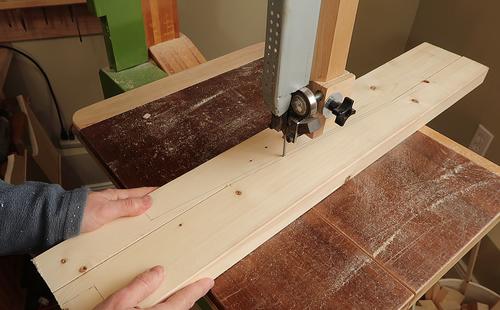 ... and a diagonal cut to separate the two pieces on the bandsaw.
... and a diagonal cut to separate the two pieces on the bandsaw.
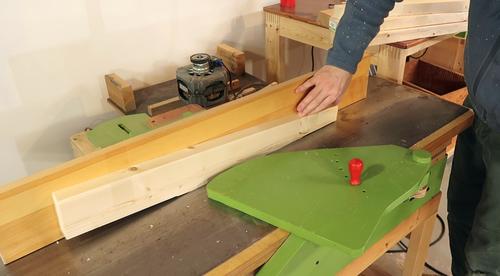 I then cleaned up the diagonal bandsaw cut on the jointer, planing off a little
bit at a time until I cut up to the line.
I then cleaned up the diagonal bandsaw cut on the jointer, planing off a little
bit at a time until I cut up to the line.
 Marking where the mortise goes on the four legs.
Marking where the mortise goes on the four legs.
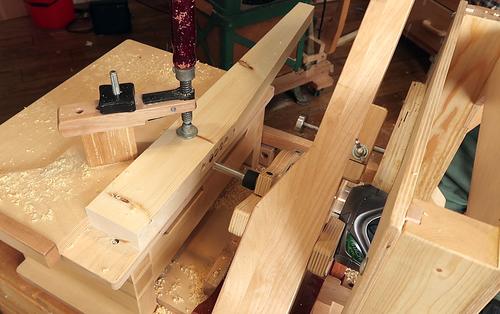 Cutting the mortise on the pantorouter. First I cut a series of holes
by plunging to remove the bulk of the material, then I swept side-to-side
to form a slot.
Cutting the mortise on the pantorouter. First I cut a series of holes
by plunging to remove the bulk of the material, then I swept side-to-side
to form a slot.
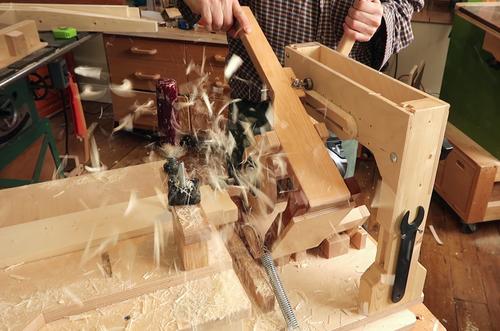
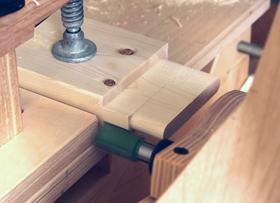 Cutting the tenons on the pantorouter. I don't have a good way of catching
the chips on this one, and when working fast, the chips really fly.
But after about 15 seconds, the tenon is finished.
Cutting the tenons on the pantorouter. I don't have a good way of catching
the chips on this one, and when working fast, the chips really fly.
But after about 15 seconds, the tenon is finished.
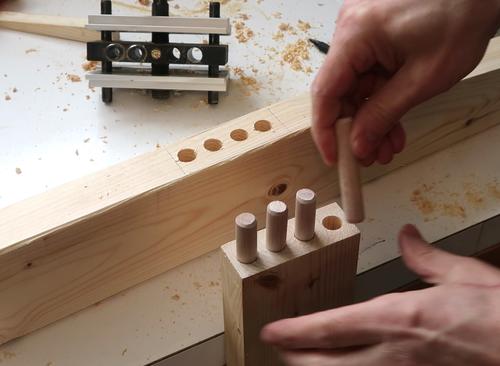 I used the pantorouter because I have one, but if you don't have one,
you could just as well make this joint using four 1/2" dowels instead.
I used the pantorouter because I have one, but if you don't have one,
you could just as well make this joint using four 1/2" dowels instead.
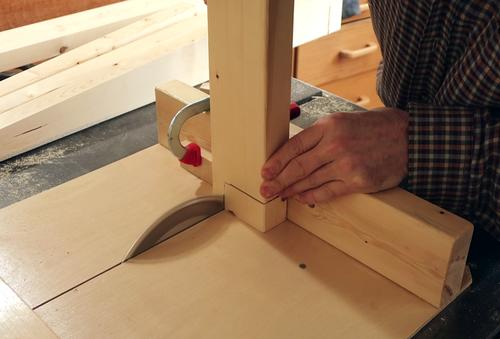 A notch needs to be cut out of the top of the legs, I cut this with two
cuts on the table saw. Though this saw, especially with a table saw sled,
doesn't cut deep enough, so I had to finish the cut on the bandsaw.
A notch needs to be cut out of the top of the legs, I cut this with two
cuts on the table saw. Though this saw, especially with a table saw sled,
doesn't cut deep enough, so I had to finish the cut on the bandsaw.
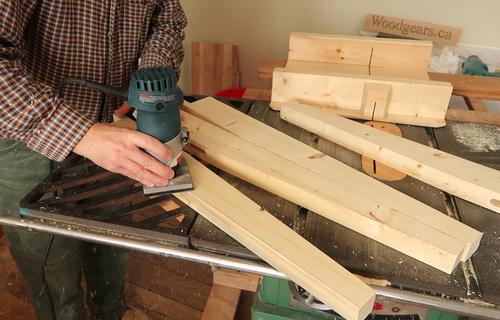 I added a 1/4" roundover to the legs and the stretchers that
go in between.
I added a 1/4" roundover to the legs and the stretchers that
go in between.
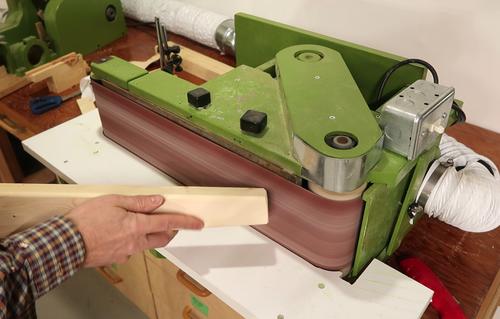 I also chamfered the bottom of the legs, but on the
belt sander. That way
I didn't have to get awkward with the router and didn't have to worry
about chip-put.
I also chamfered the bottom of the legs, but on the
belt sander. That way
I didn't have to get awkward with the router and didn't have to worry
about chip-put.
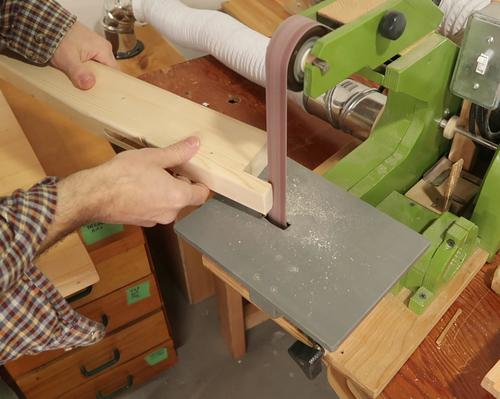 I used my strip sander to sand into the corners where the belt sander
couldn't reach.
I used my strip sander to sand into the corners where the belt sander
couldn't reach.
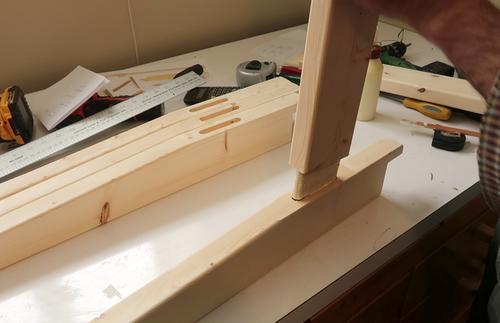 Then gluing the legs and stretchers together.
Then gluing the legs and stretchers together.
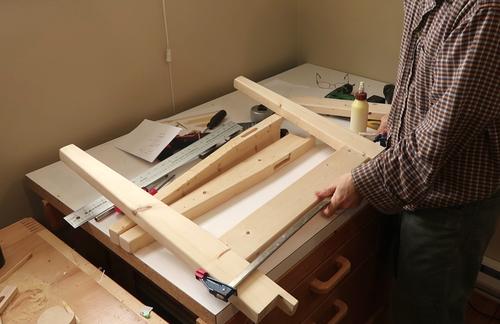 I used a long clamp to make sure the joints were fully closed.
I used a long clamp to make sure the joints were fully closed.
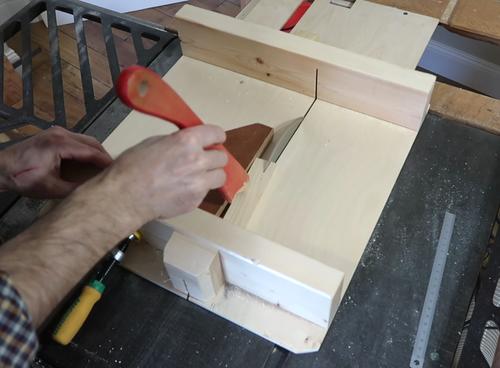
 The next step was to work on the brackets that attach the two pairs
of legs to the rails that go along the table.
The next step was to work on the brackets that attach the two pairs
of legs to the rails that go along the table.
I started by cutting the wedges that lock the legs onto the brackets.
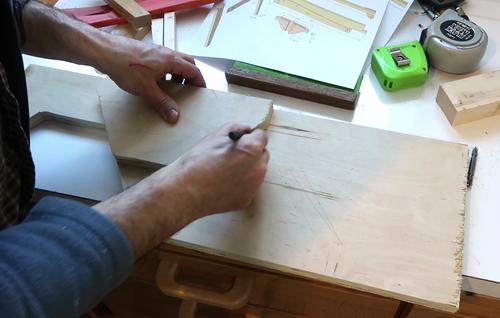 Next I draw the shape of the main part of the bracket and cut that out and used
that part to lay out three more of them. Unfortunately, this scrap of plywood
wasn't big enough for four of them.
Next I draw the shape of the main part of the bracket and cut that out and used
that part to lay out three more of them. Unfortunately, this scrap of plywood
wasn't big enough for four of them.
 I laid out another of these pieces on a piece of plywood, along with the smaller
triangles that go on either side.
I laid out another of these pieces on a piece of plywood, along with the smaller
triangles that go on either side.
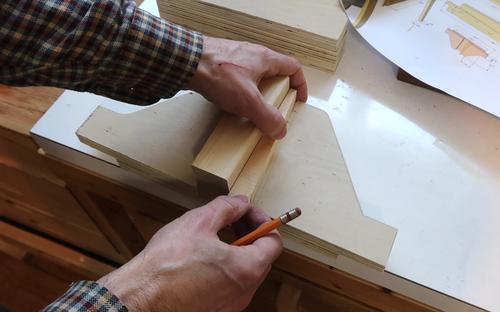 The triangle on one side needs to be at an angle to match the shape of the wedge,
here checking how it all goes together, with a scrap of wood as a stand-in
for the leg.
The triangle on one side needs to be at an angle to match the shape of the wedge,
here checking how it all goes together, with a scrap of wood as a stand-in
for the leg.
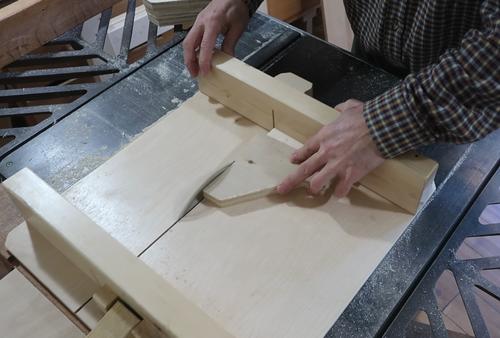 I then used one of the wedges as an angle guide for cutting the end of
the bracket at a matching angle.
I then used one of the wedges as an angle guide for cutting the end of
the bracket at a matching angle.
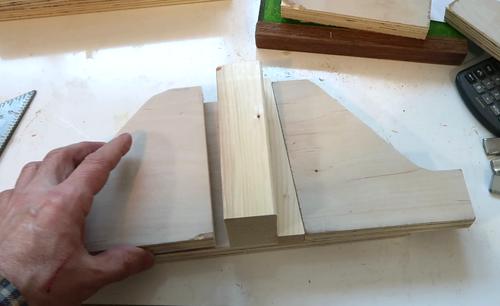 Checking how it all goes together.
Checking how it all goes together.
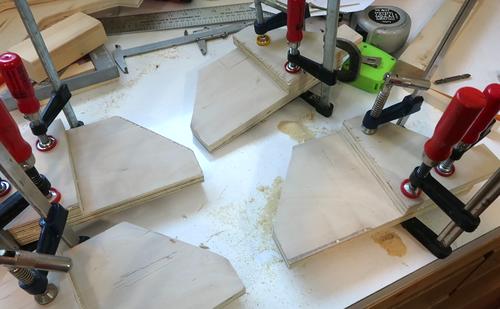 Next I glued the square (not angled) part of the bracket on each bracket.
Two of these are mirror images of the other two.
Next I glued the square (not angled) part of the bracket on each bracket.
Two of these are mirror images of the other two.
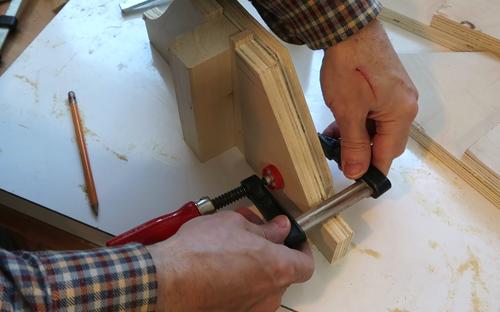 After the glue dried, again using a scrap of wood as a stand-in for
the leg, plus one of my wedges to
determine the position of the other part of the bracket.
After the glue dried, again using a scrap of wood as a stand-in for
the leg, plus one of my wedges to
determine the position of the other part of the bracket.

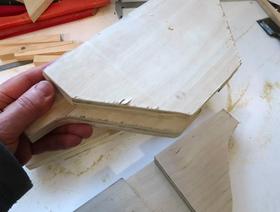 I wasn't very careful about exactly lining up the layers as I glued them,
so the brackets all looked very rough.
I wasn't very careful about exactly lining up the layers as I glued them,
so the brackets all looked very rough.
But then I cut all the outside dimensions to final size, which made the alignment perfect.

 Then sanding all the edges on my belt sander. I used my strip sander to
get into the corners that the belt sander could not reach.
Then sanding all the edges on my belt sander. I used my strip sander to
get into the corners that the belt sander could not reach.
 Much better looking brackets now!
Much better looking brackets now!
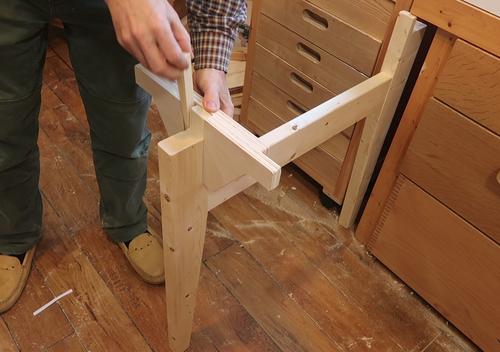 Testing how the brackets lock onto the legs with a wedge.
Testing how the brackets lock onto the legs with a wedge.
Now I just need to attach these brackets to some 2x4s to support the table top.
 After that I varnished the legs and the brackets of the table.
After that I varnished the legs and the brackets of the table.
 I needed some straight 2x4s to attach the brackets to,
but none of the 2x4 I had at hand were were straight.
I needed some straight 2x4s to attach the brackets to,
but none of the 2x4 I had at hand were were straight.
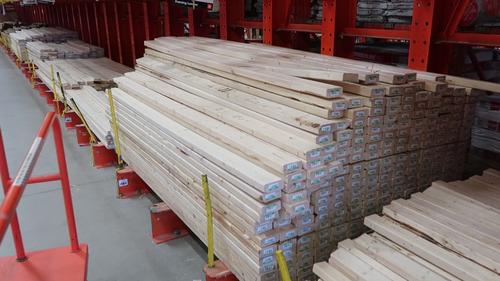 So I went to the Home Depot to pick out some straight ones. They had a
whole pile of 2x4 with all kinds of twists and curves, but I managed to find
two that were very straight.
So I went to the Home Depot to pick out some straight ones. They had a
whole pile of 2x4 with all kinds of twists and curves, but I managed to find
two that were very straight.
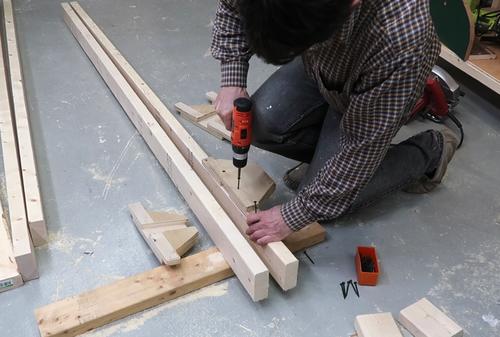 Then screwing on the brackets.
Then screwing on the brackets.
My original intention was to glue and screw them on, but I can't be sure that these 2x4s won't warp eventually, so I opted for just screws.
 I then took what I had so far out to the garage where I had a sheet of plywood,
already cut down the middle when I bought it.
I then took what I had so far out to the garage where I had a sheet of plywood,
already cut down the middle when I bought it.
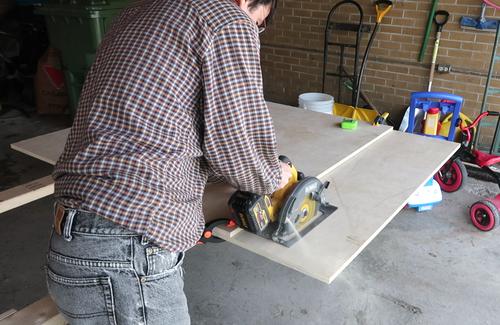 I wanted the table to be 1 meter (40") wide, but the plywood was 1.22 meters (48") wide.
I used the pieces of plywood as a saw guide for each other to cut the extra piece off.
I wanted the table to be 1 meter (40") wide, but the plywood was 1.22 meters (48") wide.
I used the pieces of plywood as a saw guide for each other to cut the extra piece off.
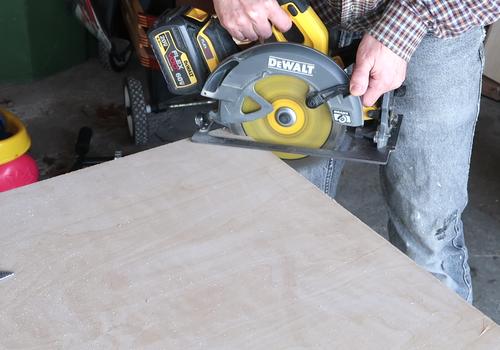
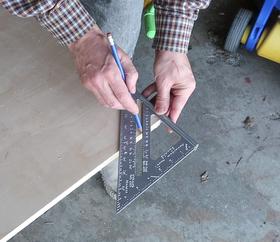 I also cut off the corners, first marking where I wanted to cut with a speed square,
then cutting it off with a circular saw.
I also cut off the corners, first marking where I wanted to cut with a speed square,
then cutting it off with a circular saw.
But this cut, unlike the width cuts that I made, was across the grain, which means chip out is more likely. I made the cut by pushing the saw through the wood backward, so it cut on the back of the blade where the teeth are moving down. Be warned: cutting backward with a circular saw is not safe.
 After that I used a small belt sander to chamfer all the edges and round the corners.
After that I used a small belt sander to chamfer all the edges and round the corners.
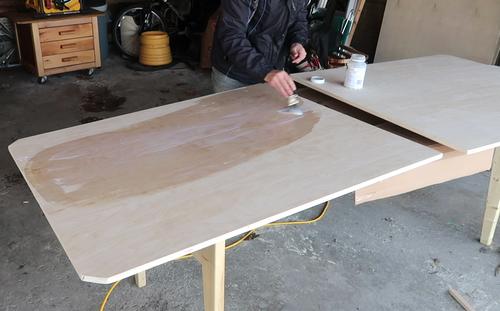 I then pored some varnish on the top and used a brush to spread it out and also cover
the edges. I used three coats of water based varnish as usual.
I then pored some varnish on the top and used a brush to spread it out and also cover
the edges. I used three coats of water based varnish as usual.
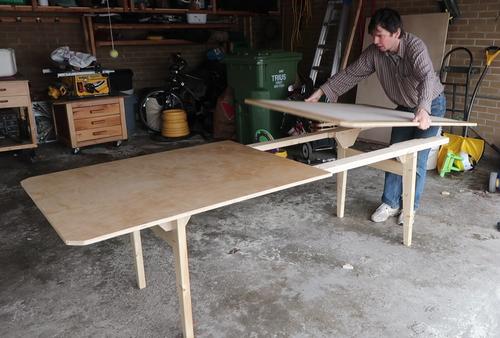 I then flipped the table halves to drill some holes in the bottom.
I then flipped the table halves to drill some holes in the bottom.
The reason the top is as two halves is to make the table easier to move around.
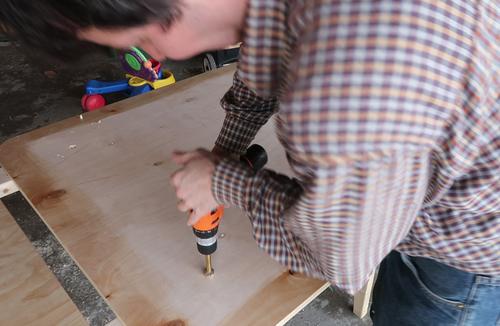
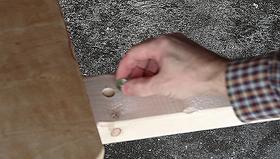 I then drilled some 3/4" (19 mm) holes on the bottom of the top.
I then drilled some 3/4" (19 mm) holes on the bottom of the top.
Marbles placed into holes on the rails line up with these holes to keep the top from sliding around. The marbles are 16 mm (5/8") in diameter and are placed into 5/8" holes that are 8 mm deep, so that half the marble sticks out the top.
 Getting that alignment just right is tricky, which is why the top as 19 mm
(3/4") holes to add a bit of tolerance.
Getting that alignment just right is tricky, which is why the top as 19 mm
(3/4") holes to add a bit of tolerance.
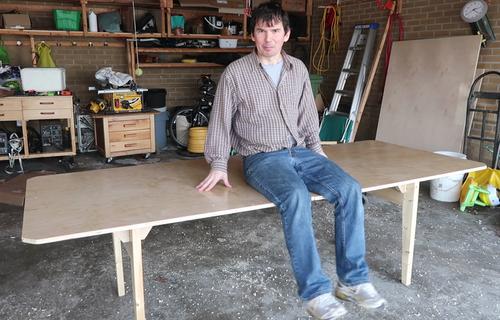 After that, doing my usual flying leap jump test. The table stood up to
it just fine, though the ends of the top did jump a little from that.
After that, doing my usual flying leap jump test. The table stood up to
it just fine, though the ends of the top did jump a little from that.
Screwing the top of the table down would fix that, but that would make it much more difficult to put up and take down.
 Miter joined table (2020)
Miter joined table (2020)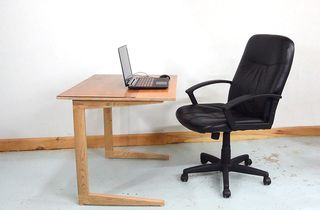 Small work table (2016)
Small work table (2016) Older adjustable table (2006)
Older adjustable table (2006)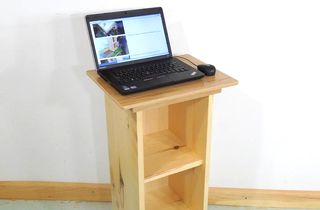 Stand-up laptop table (2012)
Stand-up laptop table (2012)  Knock down student desk (2007)
Knock down student desk (2007) Kid's table (2010)
Kid's table (2010)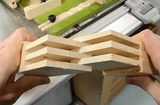 Multi-lap joint (2014)
Multi-lap joint (2014) Building wooden chairs (2020)
Building wooden chairs (2020)